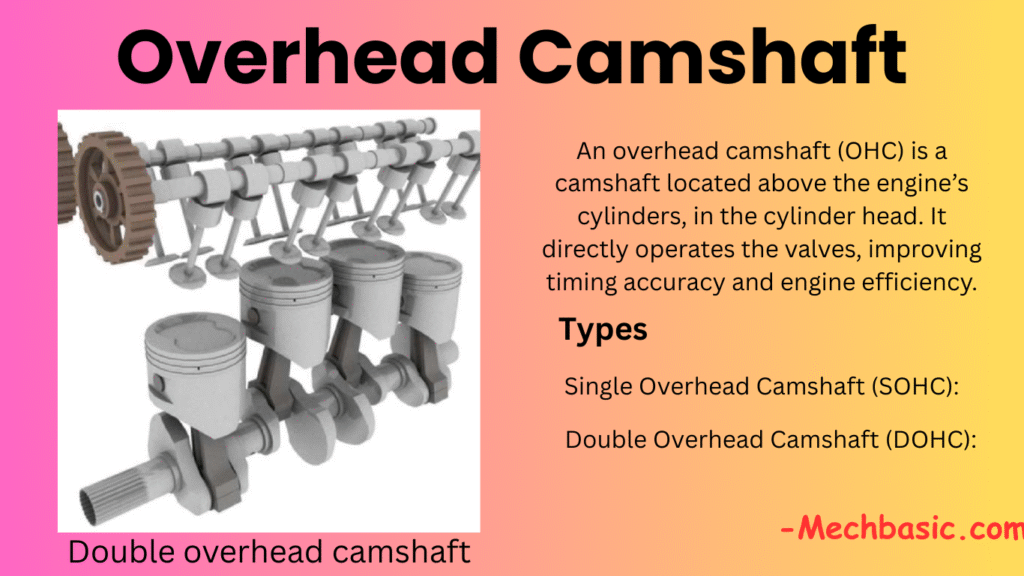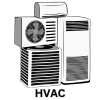
In this article:
- What is an overhead camshaft engine?
- Types of Overhead camshaft engines:
- Components of Overhead camshaft engine:
- Working of Overhead camshaft engine:
- 🧠 SOHC vs DOHC Valve Control:
- 🧪 Example: DOHC 4-Cylinder Engine (16 valves)
- Advantages of overhead camshaft engine:
- Disadvantages of overhead camshaft engine:
- Applications of overhead camshaft engine:
- Conclusion:
- FAQ Section:
What is an overhead camshaft engine?
An overhead camshaft (OHC) engine is a type of internal combustion engine where the camshaft is located in the cylinder head, above the combustion chamber and valves. This design allows the camshaft to directly operate the intake and exhaust valves, eliminating the need for pushrods (as used in OHV engines).
Function of camshaft:
The camshaft uses lobes to control:
- When intake valves open to let air/fuel in.
- When exhaust valves open to let combustion gases out.
In an OHC engine, the camshaft’s rotation is usually driven by a timing belt, timing chain, or timing gears connected to the crankshaft.
Types of Overhead camshaft engines:
| Type | Description |
|---|---|
| SOHC (Single Overhead Camshaft) | One camshaft per cylinder head controls both intake and exhaust valves. Common in inline engines. |
| DOHC (Double Overhead Camshaft) | Two camshafts per cylinder head: one for intake valves, one for exhaust. Found in multi-valve engines and most modern designs. |
Components of Overhead camshaft engine:
Camshaft (overhead) – Rotates in the head and actuates valves.
Rocker arms or cam followers – May be used to transmit motion.
Valves (intake & exhaust) – Open/close at precise times.
Timing mechanism – Synchronizes camshaft and crankshaft.
Cylinder head – Houses camshaft and valvetrain components.
Working of Overhead camshaft engine:
Certainly! Here’s a detailed explanation of the working of an Overhead Camshaft (OHC) engine, including how its components interact to operate the valves.
1. Power Transmission to the Camshaft:
- The crankshaft (driven by the pistons) turns the timing belt or timing chain, which connects to the overhead camshaft.
- The camshaft rotates at half the speed of the crankshaft because the engine operates on a four-stroke cycle.
2. Camshaft Rotation and Valve Actuation:
As the camshaft rotates:
- Its lobes (cams) push against cam followers, rocker arms, or directly on valve tappets (depending on engine design).
- This movement opens the intake and exhaust valves at precise intervals based on the camshaft profile.
3. Valve Operation Timing
Each valve opens and closes during specific strokes of the four-stroke cycle:
| Stroke | Valve Action |
|---|---|
| Intake Stroke | Intake valve opens, piston moves down, drawing in air-fuel mixture. |
| Compression Stroke | Both valves closed, piston moves up, compressing the mixture. |
| Power Stroke | Spark ignites compressed mixture, forcing piston down. Valves remain closed. |
| Exhaust Stroke | Exhaust valve opens, piston moves up, expelling gases. |
The camshaft ensures exact valve timing for this cycle to occur efficiently.
🧠 SOHC vs DOHC Valve Control:
✅ SOHC (Single Overhead Camshaft):
- One camshaft controls both intake and exhaust valves.
- May use rocker arms to reach valves, especially in V-type engines.
✅ DOHC (Double Overhead Camshaft):
- Two camshafts per cylinder head: one for intake valves, one for exhaust.
- Allows:
- More valves per cylinder (usually 4: 2 intake, 2 exhaust)
- Better breathing (air/fuel intake and exhaust flow)
- Higher RPM operation
- Support for Variable Valve Timing (VVT) systems
🧪 Example: DOHC 4-Cylinder Engine (16 valves)
- 2 camshafts: one operates 8 intake valves, the other 8 exhaust valves.
- Each cylinder has 4 valves: 2 intake + 2 exhaust.
- The design supports high airflow, ideal for sporty and fuel-efficient engines.
📊 Summary of the Working:
| Step | Action |
|---|---|
| 1 | Crankshaft drives camshaft via belt/chain |
| 2 | Camshaft lobes rotate and press valve mechanism |
| 3 | Valves open to allow air/fuel or exhaust gas movement |
| 4 | Springs close valves when cam lobe moves away |
| 5 | All timed precisely for the 4-stroke engine cycle |
Advantages of overhead camshaft engine:
Improved Performance – Better airflow due to more precise valve timing and multi-valve capability.
Higher RPM Capability – Shorter, lighter valvetrain enables higher engine speeds.
Fuel Efficiency – Optimized combustion improves mileage.
Lower Emissions – More controlled combustion process.
Reduced Weight – Lighter valvetrain than OHV designs.
Disadvantages of overhead camshaft engine:
More Complex Design – Especially in DOHC configurations.
Larger Cylinder Head – May increase engine height and cost.
More Expensive Repairs – More components in the head.
Applications of overhead camshaft engine:
Found in most modern cars, motorcycles, and performance engines.
Examples include engines with VVT (Variable Valve Timing) technologies like Honda VTEC, Toyota VVT-i, and BMW VANOS.
Conclusion:
An OHC engine places the camshaft above the combustion chamber for direct and efficient valve control, resulting in better performance, higher RPM capability, and fuel efficiency, making it the standard in modern engine design.
FAQ Section:
1. What is an Overhead Camshaft (OHC) engine?
An OHC engine is a type of internal combustion engine where the camshaft is located above the cylinder head, directly operating the intake and exhaust valves.
2. How does an OHC engine differ from an Overhead Valve (OHV) engine?
In an OHV (pushrod) engine, the camshaft is located in the engine block and uses pushrods to operate valves. In OHC engines, the camshaft is above the valves, eliminating the need for pushrods, improving efficiency and high-RPM performance.
3. What are the types of OHC engines?
There are two main types:
- SOHC (Single Overhead Camshaft): One camshaft per cylinder head.
- DOHC (Dual Overhead Camshaft): Two camshafts per cylinder head, typically for better performance and efficiency.
4. What are the advantages of OHC engines?
- Higher RPM capability
- Better airflow and performance
- More precise valve timing
- Improved fuel efficiency and emissions
5. Are OHC engines more fuel-efficient?
Yes, generally OHC engines offer better fuel efficiency than OHV engines due to more precise valve timing and reduced valvetrain mass.
6. Are OHC engines more complex or expensive to maintain?
OHC engines are typically more complex and may cost more to maintain or repair due to their intricate timing components like belts or chains.
7. Do OHC engines use timing belts or chains?
They can use either. Timing belts are quieter and cheaper but need regular replacement. Timing chains are more durable but may be noisier and heavier.
8. Is a DOHC engine better than a SOHC engine?
DOHC engines allow for more valve control (often 4 valves per cylinder), leading to better performance and efficiency. However, SOHC engines are simpler and can be more cost-effective.
9. Are OHC engines suitable for all types of vehicles?
Yes, they are widely used in everything from economy cars to high-performance sports cars and motorcycles due to their versatility and performance benefits.
10. What are common problems with OHC engines?
- Timing belt/chain wear or failure
- Valve timing issues
- Camshaft or rocker arm wear
- Oil leaks from camshaft seals
Other courses:



